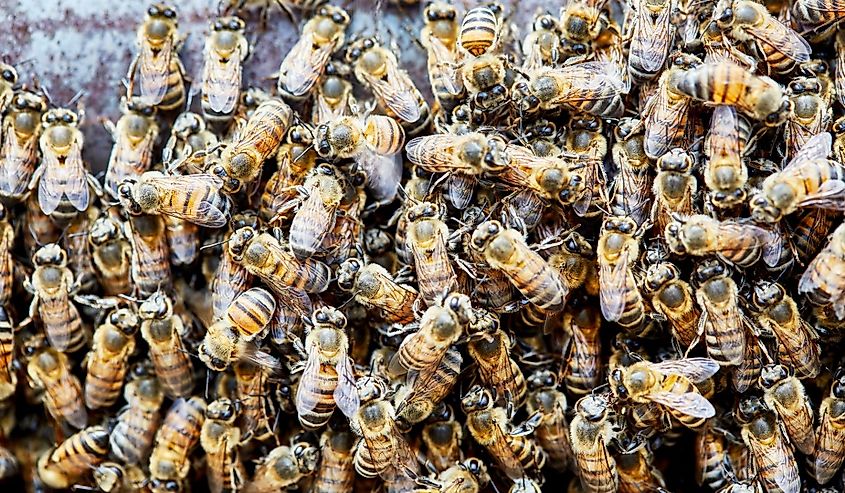
5 Most Dangerous Insects in Hawaii
Hawaii's tropical climate, although perfect for a relaxing beachside vacation, also makes it an ideal place for a variety of potentially dangerous insects. From killer bees to pesky ants, Hawaii’s insect population includes several species that can cause significant harm to humans.
Understanding the dangers these insects present and knowing how to avoid them is a good way for residents and visitors alike to protect themselves, whether outside or indoors. Explore some of Hawaii’s most dangerous insects and learn tips for minimizing risk.
Africanized Honey Bee

The Africanized honey bee (Apis mellifera scutellata), commonly referred to as the "killer bee," is a hybrid and invasive species found in Hawaii and several other American states that poses a significant threat due to its highly defensive behavior. These bees resemble European honey bees in appearance but are far more aggressive and likely to swarm when their hive is disturbed.
When provoked, Africanized honey bees can attack in large numbers, delivering multiple stings that can cause intense pain, swelling, and, in some cases, life-threatening allergic reactions or anaphylaxis. Their venom is not more potent than that of other bees, but the sheer number of stings increases the danger. Seek immediate medical attention for more than 15 stings or severe symptoms.
Mosquito

Mosquitoes (Culicidae) are among the most dangerous insects in Hawaii due to their role as vectors for diseases such as dengue fever, Zika virus, and chikungunya. Though malaria is not present in Hawaii, the risk of mosquito-borne illnesses remains a concern for all who venture outside.
Two primary species are responsible for disease transmission: Aedes aegypti and Aedes albopictus. These mosquitoes are small, with black-and-white striped legs, and are most active during the early morning and late afternoon. They thrive in warm, humid conditions and lay eggs in standing water, making backyard items like buckets or plant saucers potential breeding grounds.
Try your best to eliminate stagnant water on your property, use insect repellents containing DEET or picaridin, and wear protective clothing when outside, especially if you are in the wilderness. Mosquito nets and screens further reduce exposure indoors.
Public health efforts in Hawaii focus on monitoring mosquito populations and controlling outbreaks to protect residents and visitors alike.
Little Fire Ant

The Little Fire Ant (Wasmannia auropunctata) is another highly invasive species in Hawaii, known for its painful stings and destructive impact on the island chain's ecosystems. Measuring only about 1.5 millimeters in length (hence the name), these reddish-orange ants are tiny but aggressive, forming dense colonies in trees, gardens, and homes.
Their stings cause intense, burning pain, often followed by itchy welts that can last for days. For some individuals, multiple stings can trigger severe allergic reactions that may even be deadly. These ants also threaten agriculture and wildlife by displacing native species and damaging crops.
Little Fire Ants are spread through infested plants, soil, or cargo. Preventing their spread involves inspecting plants and using bait-based pest control measures.
Argentine Ant

The Argentine Ant (Linepithema humile) is another invasive species in Hawaii, known for its highly aggressive nature and disruptive impact on native ecosystems. Small and light brown, these ants form massive colonies that can dominate urban and natural environments, often outcompeting native species on Hawaii's various islands.
Argentine Ants are a nuisance to humans due to their tendency to invade homes in search of food and water. While they do not sting, their bites can cause minor irritation. Their real danger lies in their ecological impact, as they displace native insects and disrupt pollination.
Public awareness and coordinated control efforts have been made to minimize the spread of Argentine ants and protect Hawaii’s ecosystems from further harm. If you think they are infesting your property or a place near you, be sure to contact a licensed pest control company.
Western Yellow Jacket Wasp

Western Yellow Jackets (Vespula pensylvanica (Saussure)), a type of wasp commonly found in Hawaii, are aggressive, stinging insects that pose a danger to humans and animals. These wasps, which are also found across North America, are typically black and yellow with a slender body. They live in large colonies, often located underground, in tree hollows, or near human dwellings where food and waste are abundant.
Yellow Jackets are highly territorial and will sting repeatedly if their nest is threatened. Their stings can cause intense pain and can leave a red mark on your skin. Like a lot of stinging insects, severe allergic reactions, such as anaphylaxis, can happen in some people. Encounters are especially dangerous during the warmer months when their activity peaks.
To reduce the risk of stings, avoid areas where nests are visible, cover food and beverages during outdoor activities, and keep trash bins tightly sealed. If a nest is discovered, professional pest control services should be contacted to remove it safely.
Know Hawaii's Dangerous Creatures
While Hawaii is known for its highly unique and diverse wildlife, certain insects can pose health risks to both residents and visitors. From disease-carrying mosquitos to the painful stings of yellow jackets, it is important to exercise caution while exploring this otherwise island paradise.
Staying informed helps ensure a safer experience in Hawaii’s beautiful environment, and it can even improve your ability to protect its delicate environment. Although dangerous and sometimes scary, these insects are still a major part of the great ecosystem and should be respected as such.











